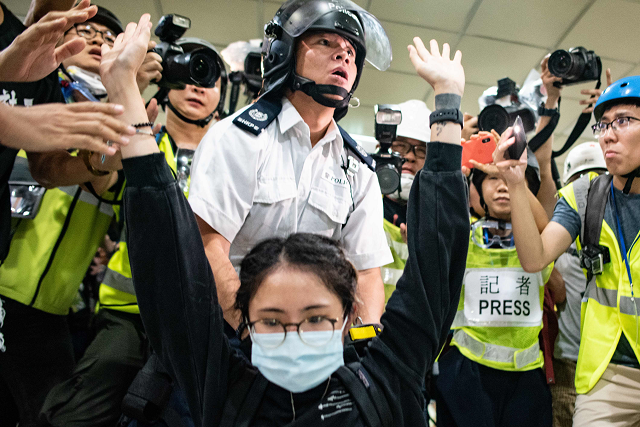
The chants directed at Beijing's egg-splattered Liason Office on Sunday night were a vivid rebuke to China as the semi-autonomous finance hub entered its seventh straight week of anti-government protests that show no sign of abating.
"Reclaim Hong Kong, the revolution of our time," the crowds shouted, spraying the same slogan on nearby walls.
Hong Kong braces for fresh anti-government march
The phrase was the campaign slogan of Edward Leung, a leading pro-independence activist currently in jail for rioting.
"He proposed the idea of a Hong Kong nation. That Hong Kong people belong to the same ethnic group, and that has brought together Hong Kong people's inward forces," a 29-year-old man surnamed Cheng said after the Liason Office protest moved into nearby streets on Sunday night.
"He is a kind of a spiritual leader," Cheng added.
After two decades under Beijing's rule, many young Hong Kong protesters are saying they've had enough and are increasingly focusing their rage towards the mainland -- both its government and its people.
A week before the protest outside the Liason Office, clashes broke out between police and demonstrators in a border region as the movement took aim at traders from mainland China who snap up goods in Hong Kong and resell them across the border.
Similar confrontations in early July were sparked by anger over provocative "dancing aunties" singing Mandarin pop songs through loudspeakers in public spaces.
And further protests are planned in the coming weeks in regions of the city that activists say are overcrowded with mainland visitors or traders.
Political analyst Dixon Sing said these protests are just the latest expression of years of frustration at Beijing's ramped-up footprint on a city that has long been both culturally and linguistically distinct from the mainland.
"There's a very widespread feeling that the Hong Kong government has colluded with Beijing to try and colonise the city or create the mainland station of Hong Kong through all sorts of policies," he said.
"There's a seething fear that the colonisation done by Beijing has pervaded Hong Kong on all fronts. That's why there's such an explosion of accumulated anger right now," he added.
Someone million mainlanders have migrated to Hong Kong since its 1997 handover to China, a diaspora that is a source of friction in a city of 7.3 million beset by sky-high property prices and a huge housing shortage.
But the huge daily influx of tourists and mainland traders in recent years has inflamed those tensions further, with crowds clogging the streets and mom-and-pop businesses forced to close by spiralling rents.
Around 15-18 per cent of university students are mainlanders, many of whom stay after graduating and compete with locals for jobs in a tough market.
And in a city where Cantonese is the dominant language, the Mandarin spoken on the mainland has been making in-roads, in schools, on the streets, in cinemas, shops and the workplace.
In recent years some of the more hardcore activists have taken to describing mainlanders using derogatory terms such as "locusts" and bigotry towards Mandarin speakers is not uncommon.
The animosity has not been aided by the city leadership's years of cosiness with Beijing and polarisation is deepening.
Successive Hong Kong administrations have refused calls in recent years from protesters to introduce wider democratic freedoms or to halt sliding freedoms.
Recent large rallies in support of the police and government have seen many mainlanders attend and many Chinese flags being waved.
Shortly after the Liason Office protest, pro-government thugs wielding bats beat up protesters in the rural town of Yuen Long near the Chinese border, hospitalising 45 people.
Some of the suspected triad gangsters were waving Chinese flags.
Inside China, where news and information are heavily censored, the protests have been portrayed as a violent, foreign-funded plot to destabilise the motherland.
But some protesters are trying to reach out to mainlanders in less combative ways.
Hong Kong leader condemns 'rioters' after violent mall clash
Thousands marched earlier this month through the waterfront district of Tsim Sha Tsui, an area popular with Chinese tourists, in an attempt to explain to mainland residents what the protest movement is about.
Activists used Bluetooth and Apple's AirDrop function to send to nearby phones leaflets written in the simplified Chinese characters used on the mainland instead of the traditional characters used in Hong Kong and Taiwan.
On Friday a similar protest took place at the airport arrival hall welcoming tourists, including mainlanders, to a city now smouldering with unrest.


1729662874-0/One-Direction-(1)1729662874-0-165x106.webp)














COMMENTS
Comments are moderated and generally will be posted if they are on-topic and not abusive.
For more information, please see our Comments FAQ